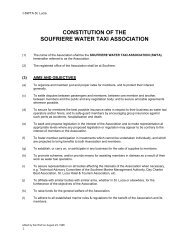WWF Cover photo - Soufriere Marine Management Association ...
WWF Cover photo - Soufriere Marine Management Association ...
WWF Cover photo - Soufriere Marine Management Association ...
Create successful ePaper yourself
Turn your PDF publications into a flip-book with our unique Google optimized e-Paper software.
8. Community-based closed areas in FijiCo-authored by Alifereti Tawake of the Institute of Applied Science (IAS), University of theSouth Pacific, Fiji and manager of the Fiji Locally-Managed <strong>Marine</strong> Area NetworkTawake_a@usp.ac.fjFiji has a very strong traditional resource management system. Communities own and manage specific areas,and there is local autonomy in decision making about use of resources (Aalbersberg et al. 1999). In the early1990s, in response to the now familiar story of a community coming to terms with declines in marine resourcesand consequent decreasing catches (in this case of marine invertebrates), the residents of Ucunivanua village inthe Verata district of Fiji decided they had to deal with these problems. In consultation with the University of theSouth Pacific and the Biodiversity Conservation Network they put in place several management strategies. Theseincluded replanting mangroves, banning mangrove cutting, coral extraction and fishing using poisons, obtainingalternative income from a bioprospecting enterprise, and setting up a species-specific fishery closure.The purpose of the closed area or species refuge was to act as a replenishment zone where over-exploited specieswould have a chance to recover, and increase harvests in adjacent fishing areas by spillover. The species initiallymanaged by this closed area was the clam (Anadara sp.). In 1997 the community designated a 24ha area ofseagrass and mudflat directly in front of the village and closed it to clam harvesting. The community knows theclosed areas by local names and understands the boundaries, which are also marked using stakes and othermarkers. By implementing this refuge, the village was returning to a traditional management practice of tabuareas, temporarily closed to fishing.An important component of this project was the involvement of the Ucunivanua community in monitoring theeffects of the closed area. With the support of the University of the South Pacific, the community have beenassessing changes in abundance and size of clams in their closed area and adjacent fishing grounds. Universityscientists trained community members in sampling techniques, using transects and quadrats, and measuring theclams encountered. It took about two weeks to train the team to collect data themselves.Figure 1: Ucunivanua monitoring team counting and measuring clams found insidequadrats along their transect line in the intertidal tabu area. Photo by John Parks.60



